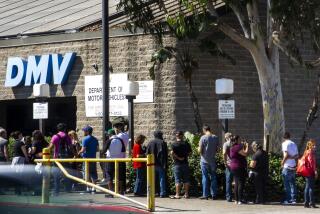Traffic Signs Can Give Some Drivers the Wrong Signal
By now, it’s hard-wired into the otherwise overworked circuitry of your brain.
Green light: Go.
Red light: Stop.
Yellow light: Stomp the gas and bomb through the intersection at all costs and never mind the old lady dragging the toddler and pushing the baby carriage with twins, or the motorcycle policeman grinning in your rear-view mirror, or the fact that you are still three cars away from the limit line. GO, FOR THE LOVE OF GOD, GO!
That’s what happens when you are paying attention, anyway.
But you may not always notice when the light has changed. In that case, of course, a harmonious B-flat chorus of little car horns (arpeggio! fortissimo! al dente!) rouses you from an otherwise pleasant slumber precisely three-hundredths of a second after the light turns green.
Or, without the prompting of fellow motorists, you sit through the entire green light. Then you stammer out a pathetic little prayer while burning rubber through a yellow light:
Not yet, not yet, please Lord I really hate missing the previews and that dopey cartoon with the stupid dancing refreshments that I can’t help laughing at, oh God, please don’t turn yet.
Actually, the traffic school teachers will tell you that yellow means nothing more than the light is about to turn red. It has no legal meaning whatsoever beyond that. None.
If the light turns from yellow to red after you have crossed the limit line, you are not breaking the law.
Not all signals are so clear, though. Some Ventura County traffic lights border on the mysterious, the baffling, the just-plain-flaky.
****
Dear Street Smart:
When I exit the southbound Ventura Freeway at the Rice Avenue/Santa Clara Avenue offramp, there is a traffic light in line with the left lane of the exit. The right lane bears off to the right and enters the southbound slow lane of Rice, and it looks like there should be a yield sign, but there is none.
If the light is red, should I stop if I want to go south on Rice? I always do, but cars behind me pass and never stop.
Philip Pszenny, Oxnard
*
Dear Reader:
Oh, what an exquisite torture that exit ramp is. You cruise into the curve on the edge of your seat, looking for a limit line, or a light you missed, or any sign to indicate NO TURN ON RED, or YIELD, or SOMETHING to say whether you are doing wrong or right. There is nothing.
It is a trick question rendered in asphalt.
Officer Dave Cockrill of the California Highway Patrol says that because the exit dumps into a lane of its own, you can cruise past a red signal to turn right at that offramp without stopping.
****
Dear Street Smart:
There is a traffic signal that needs to be adjusted.
I live in Oak Park, near the intersection of Kanan Road and Lindero Road. Heading south on Lindero, the left-turn signal to go east on Kanan comes on automatically, even though there are no cars waiting to go left on Kanan.
And cars waiting to go north on Lindero sit and sit and sit and wait and wait and wait for that signal to finally change.
It didn’t used to be that way, but it happened a couple weeks ago, and it seems to be constant. There’s no particular day or time that it happens.
Barry Stern, Oak Park
*
Dear Reader:
Thousand Oaks Traffic Engineer Jeff Knowles says this: Traffic signals are mechanical devices, with moving parts that break or malfunction.
In your case, the change in signals is not something the city programmed into the light, but probably a glitch it developed due to worn parts or a miscue in its self-tuning mechanism, which adjusts the light cycle to match changing traffic patterns.
“We rely on the sheriffs, the street inspectors, the city crews and the public at large to call my number--449-2416--whenever they see a traffic signal malfunction,” Knowles says. “I’ll call a service technician and go out and check the location. If it needs work, we’ll take care of it.”
****
Dear Street Smart:
I am writing to you about the left-turn signals on Gonzales as you turn onto H Street in Oxnard.
When you get into the left-turn lane to turn onto H, the signal across the intersection faces directly at your vehicle.
But the signal closest to the turning vehicles is pointed at an angle, so only the first two vehicles in that lane can see that the light is red or green. The vehicles farther back cannot see that signal and can only see the light across the intersection, assuming there isn’t a truck, van or larger vehicle ahead of it.
What is the logic, if there is any, behind this setup?
David L. McDuffie, Ventura.
*
Dear Reader:
Picture a traffic system as a mammoth computer chip, the very model of logic. Streets feed into boulevards, timed and controlled by signs, stripes on the pavement and pre-programmed lights laid out in patterns so logical as to make Mr. Spock quiver.
Until, that is, a motorist flattens a sign, a bored teenager “adjusts” a stoplight or the combined forces of rust and entropy grind the innards of a traffic signal into a state of disrepair.
Joe Genovese, traffic engineer for the city of Oxnard, explains:
“The near-side median left-turn signals are angled to the right to be visible to the first vehicle in the left-turn pocket.
“When we field-checked the intersection of Gonzales Road and H Street, we found that the signal for westbound traffic was a little too far out of alignment, and we have adjusted it.”
There you have it. Squeak, grease. As they say in south Philly, “Badda-boom, badda-bing, no problem.”
NEXT: Flirting with disaster.
More to Read
Sign up for Essential California
The most important California stories and recommendations in your inbox every morning.
You may occasionally receive promotional content from the Los Angeles Times.









